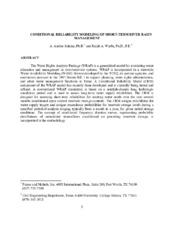| dc.description.abstract | The objective of this research was to develop a conditional reliability model that would support short-term river basin management activities in which consideration of current reservoir storage levels is important. The results are the probability of meeting water demands and instream flow requirements given specific storage conditions and water management premises. The model is a part of the Water Rights Analysis Package (WRAP), which is the set of computer programs adopted by the State of Texas through the Texas Natural Resources Conservation Commission (TNRCC) for the development of water availability studies. Two new programs, WRAP-CON and TAB-CON, were developed for incorporation in the WRAP package.
The research studied a methodology for the prediction of inflows based on conditional frequency duration curves developed for specific storage intervals. The reservoir storage is considered as a link between past flows and future flows, performing a similar role to the autocorrelation coefficient. Usually, streamflows have some degree of autocorrelation, meaning that the flow tomorrow will depend partially on the flow recorded today. In the proposed model, the reservoir level takes the place of the autocorrelation coefficient and the flow tomorrow depends on reservoir storage today. Since the reservoir preserves some memory of the flows in the past, the storage behavior contains inherently the autocorrelational properties of inflows.
This model is designed to override the assumption of all alternative flow sequences being equally likely to occur. Portions of historical inflows are routed in separate simulations, and the exceedence probability of flows is related to the diversion amountor storage achieved in each simulation. This produces the likelihood of meeting water requirements and storage levels. The reliability in the basin is expressed with parameters such as the probability of meeting or exceeding percentages of target diversions, volume and period reliability, distribution of storage in the next months, and other statistical parameters.
The model can be applied in the formulation and evaluation of drought contingency plans and operational activities. It was tested in two river basins in Texas: Guadalupe-San Antonio and Nueces. The research included the development of methodologies for the application of the model and investigation of pertinent modeling complexities. | en |


